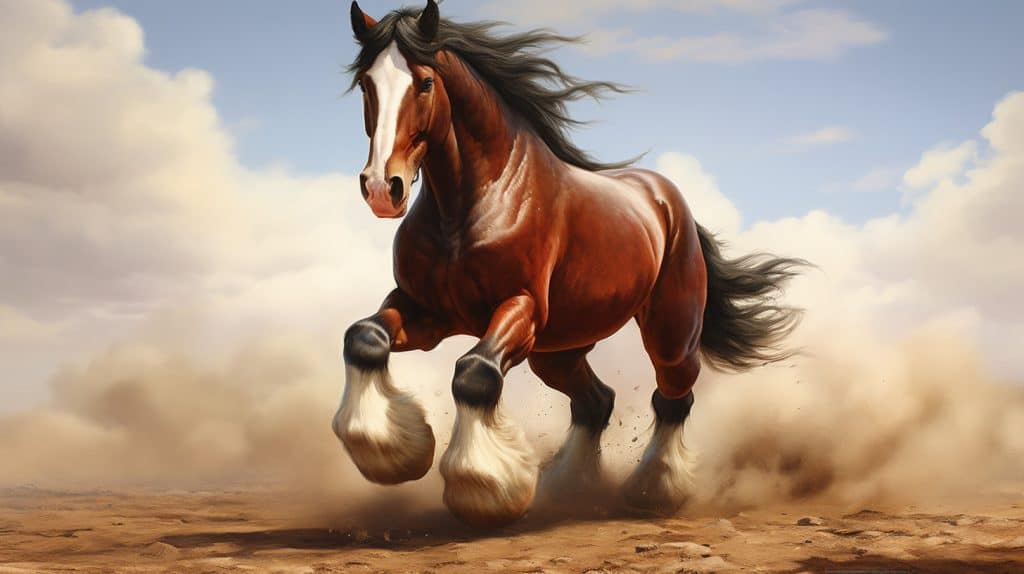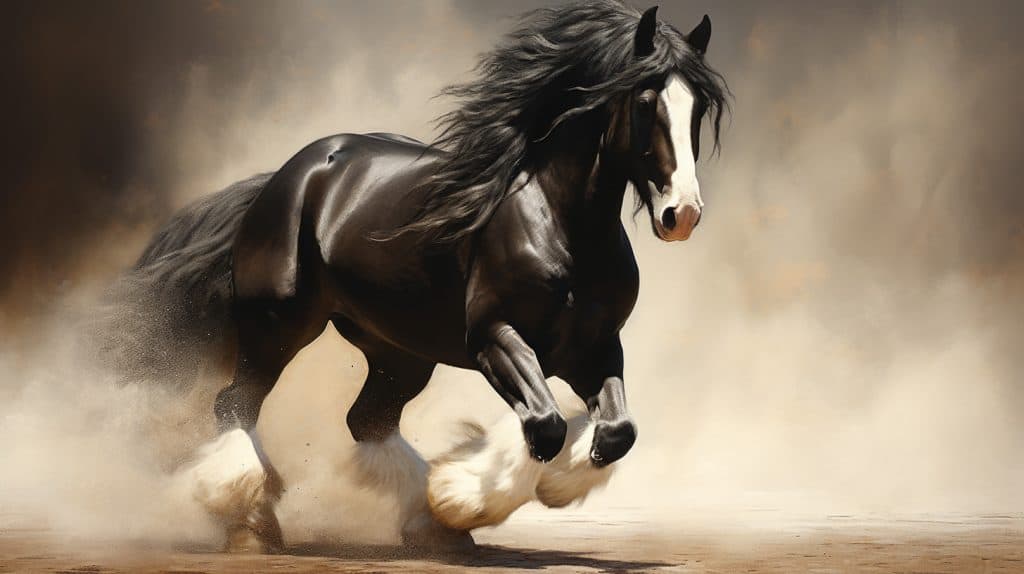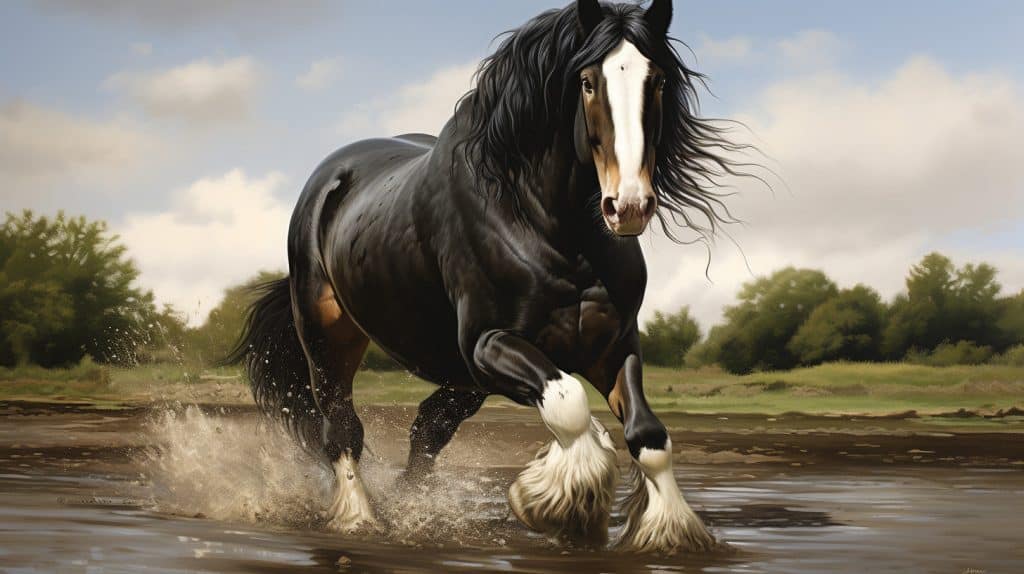Introduction
The Clydesdale horse is a powerful breed of horse, and many wonder if they can be used for dressage. The answer is yes! While they may not be the most common breed of dressage horse, Clydesdales can still be trained to compete in dressage competitions. This blog post will explore what makes Clydesdale horses uniquely suited for dressage riding and how they differ from other dressage horses.
History of Dressage Riding
Dressage is a discipline that has been around for centuries, dating back to ancient Greece. The word “dressage” itself comes from the French word “dresser,” which means to train. Throughout history, dressage has evolved and developed into the elegant and precise sport we know today.
In its early days, dressage was primarily used for military purposes. The ancient Greeks and Romans used dressage training to prepare their horses for war. The highly skilled movements and precise control required in dressage allowed the cavalry to maneuver their horses effectively in battle.
During the Renaissance period, dressage riding began to take on a more artistic and recreational purpose. Noble riders would showcase their horsemanship skills in extravagant displays for entertainment. These displays often included intricate movements and formations performed by well-trained horses.
began to take on a more artistic and recreational purpose. Noble riders would showcase their horsemanship skills in extravagant displays for entertainment. These displays often included intricate movements and formations performed by well-trained horses.
In the late 19th century, dressage became an official Olympic sport. Dressage riders from around the world began to compete against each other in various competitions, showcasing their abilities to execute complex movements with their horses. Dressage has since become a popular and respected sport in the equestrian world, with riders dedicating their lives to mastering the art of dressage.
In recent years, there has been a rise in the popularity of dressage shows and competitions. Dressage has even expanded to include different variations, such as Western dressage, which incorporates elements of Western riding styles into the traditional dressage discipline.
Today, dressage riders can be seen competing in grand dressage arenas, meticulously following dressage diagrams to execute their movements flawlessly. The sport continues to grow and evolve, with new techniques and training methods being developed to enhance the performance of both the horse and rider.
While dressage has seen its fair share of trends and fads throughout history, its essence remains the same – the partnership between horse and rider, the harmony of movement, and the pursuit of excellence. Dressage is truly a testament to the beauty and grace of the equestrian world.
The Basic Elements of Dressage
Dressage is a highly disciplined and precise sport that requires the utmost harmony and communication between horse and rider. To truly appreciate the beauty of dressage, it’s important to understand its basic elements.

One of the fundamental aspects of dressage is the horse’s balance and suppleness. A dressage horse should move freely and fluidly, with every step showcasing its athleticism and grace. Achieving this requires a combination of proper training, strength, and flexibility.
Another crucial element of dressage is the horse’s collection. Collection refers to the horse’s ability to bring its hindquarters underneath itself and carry more weight on its hind legs. This allows for increased balance, engagement, and impulsion, which are all essential for executing the intricate movements of dressage.
Precision is a hallmark of dressage, and accuracy is key. Riders must meticulously follow dressage diagrams, which provide a roadmap for each movement and transition. Every stride, every transition, and every movement must be executed with absolute precision and timing. Cadence and rhythm are also important aspects of dressage. A dressage horse should have a clear and consistent rhythm, moving with purpose and elegance. The horse’s footfalls should be evenly spaced, creating a harmonious and balanced movement.
Finally, the element of expression is a distinguishing feature of dressage. A well-trained dressage horse should display a sense of lightness and expression in its movements. The horse should appear eager, engaged, and willing to perform, showing off its natural beauty and presence.
These basic elements form the foundation of dressage, and they are what sets this discipline apart from others. Dressage is a sport that demands discipline, precision, and artistry. It is a testament to the partnership between horse and rider, the pursuit of excellence, and the beauty of the equestrian world.
Characteristics of Clydesdale Horses
Clydesdale horses are instantly recognizable with their powerful stature and feathery white feathers adorning their legs. These majestic horses have a set of characteristics that make them both unique and well-suited for dressage riding.
First and foremost, Clydesdales are known for their strength. They have a robust build with strong, muscular bodies that give them the ability to perform the demanding movements required in dressage. This strength allows them to carry themselves with grace and elegance, showcasing their impressive power at every step.
Another notable characteristic of Clydesdales is their temperament. These gentle giants have a calm and willing nature, making them well-suited for the precision and discipline of dressage. They have a natural desire to please their riders and are known for their steady and reliable demeanor. This makes them highly trainable and capable of developing the skills needed to excel in dressage.
In addition to their strength and temperament, Clydesdales also possess a unique presence and beauty. Their striking appearance, with their tall stature and flowing feathers, commands attention and creates a captivating presence in the dressage arena. Their impressive size can create a powerful visual impact, adding to the overall aesthetic of their dressage performance.
While Clydesdales may not be the most common breed seen in dressage shows or competitions, their distinctive characteristics make them stand out and capture the hearts of audiences. Their impressive strength, calm temperament, and striking presence make them a compelling choice for riders looking to make a statement in the dressage arena.
Furthermore, their presence in dressage competitions adds variety and diversity to the sport, showing that there is no one-size-fits-all approach to dressage. Clydesdales bring their own unique flair to the discipline, adding to the rich history and evolution of dressage. So, while Clydesdales may not be the typical choice for dressage riders, they possess the necessary characteristics to excel in this disciplined and elegant sport. Their strength, temperament, and presence set them apart and make them a memorable addition to any dressage show or competition. With their unique combination of power and grace, Clydesdales have the potential to achieve great success in the dressage arena and continue to captivate audiences worldwide.
Maybe you don’t know but some of the most popular Clydesdale horses around the world are the Budweiser horse. These are some of the best trained in their area and they are chosen specifically for their nature, Satrue, and their command. Check out all about the Budweiser Clydesdale Here , definitely an interesting read.
, definitely an interesting read.

Benefits of Using Clydesdales in Dressage
When it comes to dressage, Clydesdale horses offer a range of benefits that set them apart from other breeds. While they may not be the most common choice for dressage riding and riders, their unique characteristics make them a compelling option for those looking to make a statement in the dressage arena.
One of the key benefits of using Clydesdales in dressage is their strength. These majestic horses have a robust build with strong, muscular bodies that allow them to perform the demanding movements required in dressage. Their power and athleticism enable them to carry themselves with grace and elegance, making for a truly awe-inspiring performance.
is their strength. These majestic horses have a robust build with strong, muscular bodies that allow them to perform the demanding movements required in dressage. Their power and athleticism enable them to carry themselves with grace and elegance, making for a truly awe-inspiring performance.
In addition to their physical strength, Clydesdales also possess a calm and willing temperament. Known for their gentle nature, as some refer to them as gentle giants they are highly trainable and capable of developing the skills needed to excel in dressage. Their desire to please their riders and their steady demeanor make them reliable partners in the precision and discipline of dressage.
Another advantage of using Clydesdales in dressage is the visual impact they bring to the arena. Their striking appearance, with their tall stature and flowing feathers, captures attention and creates a captivating presence. This adds to the overall aesthetic of their dressage performance and leaves a lasting impression on audiences.
Moreover, incorporating Clydesdales into dressage competitions adds variety and diversity to the sport. While other breeds may dominate the dressage arena, the inclusion of Clydesdales brings a unique flair that showcases the versatility of dressage as a discipline. It challenges the notion that there is only one type of horse suited for dressage and highlights the potential for success with different breeds.
Training Clydesdales for Dressage Riding
Training Clydesdales for dressage riding can be an exciting and rewarding endeavor. While these majestic horses may not be the most common choice for dressage riders, they have the potential to excel in this disciplined and elegant sport. So, how exactly can Clydesdales be trained for dressage riding?
First and foremost, it is important to remember that training any horse for dressage requires patience, consistency, and a strong foundation in basic training. This is especially true for Clydesdales, as their size and strength can present unique challenges.
When training Clydesdales for dressage riding, it is crucial to focus on developing their balance and suppleness. This can be achieved through exercises such as circles, lateral work, and transitions. Working on these elements will help your Clydesdale develop the necessary strength and flexibility to perform the intricate movements required in dressage.

Additionally, it is important to work on collection with your Clydesdale. Collection refers to the horse’s ability to bring its hindquarters underneath itself and carry more weight on its hind legs. This not only enhances balance and engagement but also allows for increased impulsion and the execution of more advanced movements. Exercises such as shoulder-in, haunches-in, and half-pass can help develop your Clydesdale’s collection. This will only enhance the beauty of the Clydesdale in dressage riding plus for a dressage rider.
As with everything worthwhile consistency is key when training Clydesdales for dressage riding. Regular and structured training sessions will help your horse build muscle, improve their coordination, and develop a better understanding of your aids. Remember to always reward your Clydesdale for their efforts and progress, as positive reinforcement can go a long way in their training.
Another important aspect of training Clydesdales for dressage is exposing them to different environments and situations. This will help them become more confident and adaptable, which is crucial when competing in dressage shows. Attending clinics, participating in group lessons, and even taking your Clydesdale on trail rides can help build their confidence and expose them to new experiences. As with any horse, it is essential to remember that each Clydesdale is unique and may require an individualized training approach. It is important to work with a qualified dressage trainer who has experience with Clydesdales or larger breeds. They can provide guidance and tailor the training program to meet the specific needs of your Clydesdale.
is exposing them to different environments and situations. This will help them become more confident and adaptable, which is crucial when competing in dressage shows. Attending clinics, participating in group lessons, and even taking your Clydesdale on trail rides can help build their confidence and expose them to new experiences. As with any horse, it is essential to remember that each Clydesdale is unique and may require an individualized training approach. It is important to work with a qualified dressage trainer who has experience with Clydesdales or larger breeds. They can provide guidance and tailor the training program to meet the specific needs of your Clydesdale.
Challenges of Dressage Riding with Clydesdales
While Clydesdales may have the strength and temperament to excel in dressage, there are some challenges that riders may face when training and competing with these majestic horses. One challenge of dressage riding with Clydesdales is their size. Clydesdales are known for their larger build, which can make certain movements and transitions more difficult. Their sheer size can require riders to adjust their position and aids to accommodate the horse’s size and stride. Additionally, the larger stride of a Clydesdale can sometimes make it harder to maintain the precision and accuracy required in dressage. It may take additional training and practice to refine the horse’s movements and achieve the level of finesse needed in dressage.
Another challenge can be the limited availability of Clydesdales in dressage competitions. While Clydesdales are a unique and captivating addition to the dressage arena, they are not as commonly seen as other breeds. This can make it challenging for riders to find opportunities to compete with their Clydesdales and showcase their skills. However, with the increasing popularity of alternative dressage shows and the inclusion of diverse breeds, more opportunities are emerging for Clydesdales to shine in the dressage world.
Another potential challenge for dressage riders with Clydesdales is overcoming preconceived notions and biases. As Clydesdales are not the typical breed associated with dressage, there may be some skepticism or doubt from judges or other competitors. However, with dedication, skill, and a well-trained Clydesdale, riders can prove that these horses have the ability to excel in dressage. It is important for riders to remain confident in their choice of horse and to continue striving for excellence in their dressage journey.

Despite these challenges, there have been successful stories of Clydesdales in dressage competitions. Riders who have put in the time, effort, and training have been able to showcase the versatility and beauty of Clydesdales in the dressage arena. These success stories serve as inspiration for riders who are considering or currently training Clydesdales for dressage. With determination and a love for the sport, riders can overcome any challenges they may face and create a successful partnership with their Clydesdales in the world of dressage.
Overall, while there may be some unique challenges to dressage riding with Clydesdales, their strength, temperament, and presence make them a compelling choice for riders looking to make a statement in the dressage arena.
Success Stories of Clydesdales in Dressage Competitions
Dressage competitions have long been dominated by certain breeds, but there have been some remarkable success stories of Clydesdales making their mark in the dressage arena. These majestic horses, with their power, presence, and unique characteristics, have captured the attention and admiration of audiences and judges alike.
One notable success story is that of Tom and Hazel, a Clydesdale duo who defied expectations and proved that Clydesdales can excel in the world of dressage. Tom, the rider, and Hazel, his Clydesdale partner, dedicated years of training and preparation to compete in dressage shows and competitions. Their hard work paid off, as they quickly gained recognition for their performances and achievements.
Tom and Hazel’s success in dressage competitions highlights the versatility and potential of Clydesdales in this discipline. They showcased the strength, balance, and collection that are crucial in dressage, executing precise movements and transitions with finesse. Their performances wowed judges and spectators, challenging preconceived notions and biases about the ideal dressage horse breed.
Another success story is that of Jess and Sterling, a Clydesdale and rider pair that have become renowned for their expressive and dynamic dressage performances. Their ability to combine the elegance and precision of dressage with the power and presence of the Clydesdale breed has earned them numerous accolades and a dedicated fan base.
These success stories demonstrate that Clydesdales have the potential to excel in dressage competitions, regardless of breed trends or fads. While they may not be the most common choice for dressage riders, Clydesdales bring a unique flair and presence to the arena, captivating audiences with their strength, grace, and striking appearance.

The inclusion of Clydesdales in dressage shows and competitions adds diversity and variety to the sport, showcasing the wide range of breeds that can succeed in dressage. It challenges the notion that there is only one type of horse suited for dressage and highlights the potential for success with different breeds.
Conclusion
As you now see Clydesdales are extremely capable of competing in dressage riding. Some of the top people in the business will only work with these gentle giants as in each to their own they say. But the gracefulness of having a completely huge horse flowing through a dressage arena is just mesmerizing. One of the gifts they possess is beauty and grace so no wonder dressage riders choose them appropriately.
As explained correct training is needed for these competitions and safety and precaution is a first and foremost, but I think we can all agree with whatever breed of horse you are into, the respect between trainer, horse, and rider is the complete package.
Recent Posts
Mastering English Dressage: Tips and Techniques Complete Guide 101
Introduction English dressage is an equestrian sport that involves precise movements and commands between a dressage horse and its rider. It is a graceful, beautiful art form that requires skill...
Introduction Are you looking to learn more about western dressage, the art of horse dressage? If so, you've come to the right place. In the previous blog we looked at Western vs English Dressage,...

